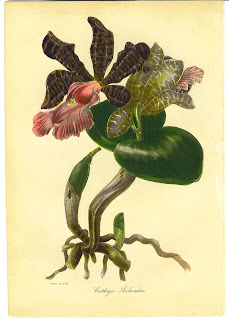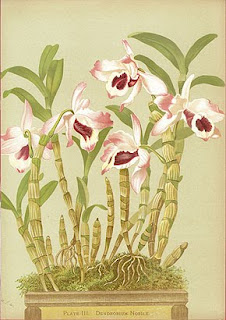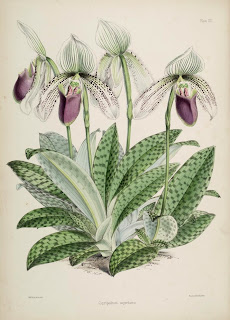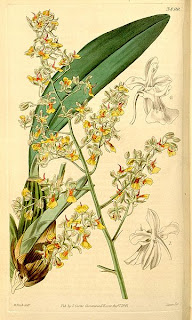
On Friday I received the new
Blc. "Ports of Paradise" Emerald Isle, mentioned in previous blog entry. Beautiful plant, nice condition. Learning from prior failure-to-
repot, I turned it out of the pot on Sat. am and
repotted it in a glazed orchid-type pot with plentiful holes in the sides for air exchange. The majority of the roots looked great. All of the leaves were nice. The original medium was not rotted or soggy. Nice plant! Pic is an old lithograph, I believe that was from 1840s.
I learned from
gardenweb and
internet sources, that
waterspots can be cleaned off from orchid leaves using lemon juice. I just used lemon juice directly from a lemon-juice squeeze bottle, and wiped the leaves with paper towel. The leaves look clean, but not the super shiny leaves that result from leaf polishes. Nice info to know!

I also looked for information on growing
Dendrobium nobile, since I have 2 specimens. It seems they should do well here, just need to know when to water, when to feed, when to leave outside, and where to put them. It appears that the most important aspect is lots of sun. Today was high 60s outside, and
overcast, so I set the
dendrobiums outside for a while. Only about 3 hours, I didn't want them to sunburn. From my reading, looks like they need generous water and feeding until August, then change to low nitrogen feeding and cut back watering. Keep outside until nights drop into the 40s. Then keep dry until they show signs of growth again. Something like that. And as much sun as they can get, especially during Summer growth. Even direct sunlight, as long as they are watered frequently and not allowed to get sunburn. Scheme is from
Yamamoto Dendrobiums, click for more readable scheme and better explanation.

19
th century print of a
Dendrobium nobile. This is a cool arrangement - instead of a round plastc pot (plastic wasn't invented for, say, another hundred years), it's sort of a box or bonzai pot, with a tree-branch-like structure and moss, and the dendrobium growing as if in nature. I like the smaller number of flowers - some modern plants seem too lavish. I spent a fair amount of
internet time determining that my plants were this species.




.jpg)









